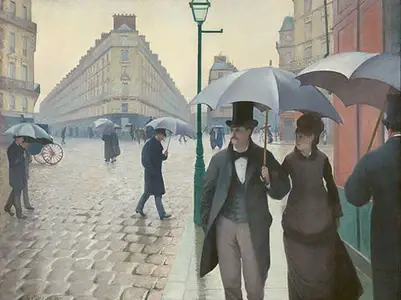Title of Artwork: “Paris Street, Rainy Day”

Artwork by Gustave Caillebotte
Year Created 1875
Summary of Paris Street, Rainy Day
When Caillebotte showed Paris Street, Rainy Day with five other pieces the year before, Zola criticised The Floor Scrapers but had a much more positive evaluation of the artist’s work. This was an issue that Zola was concerned about: “At last, I will name Mr. Caillebotte, a young painter of the most beautiful courage and who does not give up in front of full-size modern subjects,” Caillebotte’s brightness “beautifully truthful” and he might be regarded as “softened a little,” of Impressionists after he “one of the boldest of the group” he said of the people in front.
All About Paris Street, Rainy Day
At the third Impressionist group exhibition in 1877, many observers similarly connected the apparent realism of this picture by Caillebotte with photography. Such comparisons were sparked by more than simply reality, however. Significantly, the contrast between the sharp focus on the people in the front and the softening – almost blurring – of the background surroundings evokes the look of a picture. Aside than that, it’s impossible to look at this without thinking of a photograph, given how much of the image has been cropped to include the person at far right, who is barely half-way in.
Caillebotte’s paintings and the photographs of his brother Martial have recently been compared. The similarities between the brothers’ hobbies and interests, such as boat racing and rural living, as well as current engineering and building techniques and accomplishments, such as bridges and railways, are reflected in their individual artwork. It’s been argued that even though they didn’t work together directly, they shared a visual language, especially in the way photography and painting were inextricably connected in some of the most intriguing avant-garde works of the time, a connection that wasn’t always seen positively.
This artwork seems to have been divided on purpose because of a lamppost in the centre of it. However, it feels disproportionately heavy in its right half because of dark colours and individuals who appear to be heavy. It’s disconcerting, as are many of the people in the picture, some of whom seem to be at odds with one another in some way. Each one is captured like a snapshot, and this indicates that if Caillebotte did not utilise a photograph to construct the composition, he was at least thinking about formal choices that would give the image the appearance of being a photo.
According to Caillebotte historian Kirk Varnedoe, many of the artist’s paintings began as tiny, realistic drawings that are nearly exactly the same size as the plates his brother, Martial, used to create photographs.
Using life-size figures, this massive painting depicts a particular location in modern Paris: the Place du Dublin, which is near the Gare Saint-Lazare (Saint Lazare Train Station). Historic buildings were demolished or destroyed as part of the reconstruction effort after World War I to make way for the broad boulevards that are now so characteristic of modern-day Paris. As a result, this artwork honours both the advancement of photographic technology and the modernization of cities.
Caillebotte’s paintings, in contrast to those of other Impressionists like Monet and Pissarro, have been interpreted as lamenting the effects of industrialization and modernity on Paris and its environs, seem to have had a more upbeat outlook.
Many critics, including Varnedoe, believe that Caillebotte was a Realist rather than an Impressionist because of the precision with which works like Paris Street, Rainy Day were painted. This is because Impressionism was a practise that was painted on-site, often en Plein air, rather than in the artist’s studios studying drawings or photographs on which to base their paintings. As a result, the argument appears to be irrelevant. After all, other artists, like Degas, worked as well in their studios and outside of them, and many of their compositions and themes were inspired by photographs.
Many critics, including Varnedoe, believe that Caillebotte was a Realist rather than an Impressionist because of the precision with which works like Paris Street, Rainy Day were painted. This is because Impressionism was a practise that was painted on-site, often en Plein air, rather than in the artist’s studios studying drawings or photographs on which to base their paintings. For one thing, other painters like Degas worked just as much in their studios as they did on-site and also relied heavily on photography to create numerous compositions as well as works with a specific theme.
Information Citations
En.wikipedia.org, https://en.wikipedia.org/.






















